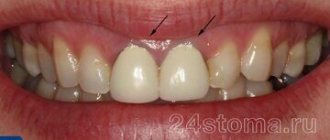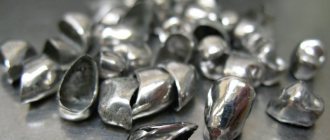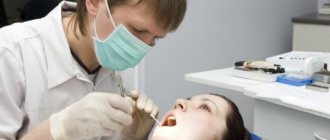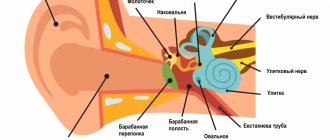In the lateral sections, teeth (molars, premolars) are subject to regular high loads, while their anatomical structure and location in the dentition makes care more difficult. Therefore, chewing units are destroyed faster due to various injuries and dental diseases. Prosthetics of molars and premolars involves the use of structures made of durable, reliable materials that are resistant to severe chewing loads. Dental crowns are orthopedic structures for single restorations, indicated when the upper part of the tooth is destroyed by more than 60%, when the installation of a filling is ineffective.
Types of dental crowns for chewing teeth
Molars and premolars are a kind of millstones that grind food before it enters the esophagus. They experience a high load, which can exceed 75 kg per 1 cm2. Therefore, chewing units are characterized by a massive size, a surface with many protruding tubercles. To restore molars and premolars, strong, reliable materials are used that can withstand increased loads. Orthopedic dentistry offers the following types of crowns for chewing teeth:
- Metal
– durable, corrosion-resistant, service life up to 10-12 years. The list of materials from which these structures are created includes: nickel-chromium alloy, cobalt-chromium alloy, titanium, alloys of noble metals (platinum, silver, gold, palladium). Solid metal alloy prostheses can be coated or not. These are the most inexpensive crowns, but the aesthetics leave much to be desired. Structures containing gold are characterized by high ductility and fit precisely to the tooth stump. The disadvantages of such dentures include excessive abrasion of the antagonist tooth (molar, premolar on the opposite jaw) with constant contact, poor aesthetics, and the development of allergies to the components of the metal alloy (beryllium, chromium, nickel). - Metal-ceramic
- reliable, durable dentures with a metal frame coated with a layer of ceramic mass. Metal-ceramic crowns are quite aesthetic, with an optimal ratio of reasonable price and good quality. Over time, the metal base begins to appear through the gums (gray stripe effect), which negatively affects the aesthetics. Therefore, it is not recommended to place such dentures on teeth along the smile line. - Crowns made of zirconium dioxide
are strong, durable structures that retain their original appearance throughout their service life (more than 15 years). The aesthetics are not inferior to ceramics and provide the tooth with a natural appearance. The biocompatible material is suitable for patients with metal allergies and is used for restoration of the frontal and chewing areas. The structures are manufactured using CAD/CAM technology, on a robotic machine, by milling. This eliminates any errors or inaccuracies, ensures precise fit of the structure to the tooth stump and gum, taking into account the type of jaw closure and the characteristics of the bite. - Metal-plastic
- inexpensive structures, which are a frame made of a metal alloy lined with plastic mass. Due to the porosity of the material, the surface of the prosthesis quickly darkens and absorbs dyes and odors from foods, drinks, and cigarettes. The metal alloy can provoke inflammation and allergies. Service life up to 3 years. Typically, such products are used for temporary prosthetics; they are unreliable as a permanent prosthetic structure.
Ceramic crowns are not suitable for the restoration of molars and premolars. Fragile ceramics are not able to withstand high chewing loads and quickly chip and crack. Ceramic crowns are placed on the front teeth, where the main criterion is high aesthetics. The incisors and canines are not subject to high loads, but participate in the formation of a smile and are visible during conversation. Ceramic restorations are identical to natural enamel in color and transparency and do not stand out from the dentition.
Human teeth designation
Taking into account the anatomical structure, the teeth of an adult are divided into different groups:
- Incisors
- Normally, there are central and lateral incisors on the upper and lower jaws, only 4 upper and 4 lower. In total, the incisal group consists of 8 teeth. The physiological task of this group is to bite or cut off pieces of food.
- Fangs
- Normally, they are represented by 2 upper and 2 lower canines, for a total of 4.
- The task of the fangs is to separate the dentition when crushing and grinding food, to prevent the upper and lower dentition from abrading and rocking against each other.
- Small molars (premolars)
- Normally there are 4 upper and 4 lower ones, for a total of 8.
- The task of the premolars is the primary grinding of food for subsequent delivery to the large molars.
- Large molars (molars)
- Normally, they can be present in numbers from 4 to 6 on the upper jaw, and from 4 to 6 on the lower jaw. The last (third molars) are wisdom teeth that may not be present or may not erupt. Thus, there can be from 8 to 12 teeth in this group. The task of molars is to grind food to the state of a homogeneous food bolus, when the reflex act of swallowing becomes possible.
Stages of installing a crown on a chewing tooth
- Diagnostics
– a comprehensive examination (orthopantomogram, 3D tomography), the dentist determines the general condition of the oral cavity, identifies dental problems, the presence of contraindications, draws up a treatment plan, and selects the optimal orthopedic design. - Preparation
- sanitization of the mouth (removal of plaque, tartar), treatment of teeth and gums (according to indications). The tooth is prepared for covering with a crown - the enamel is prepared, giving the stump the desired shape, the nerve is removed, the canals are filled, and, if necessary, the root is strengthened with a pin or inlay. To install zirconium structures, minimal tissue grinding is required; at the ILATAN clinic, a dental microscope is used for preparation, which allows you to remove enamel within a fraction of a millimeter. - Casts
- the doctor takes impressions of the patient’s jaws, from which a prosthesis is made in the laboratory. To protect the tissue, a temporary plastic crown is fixed to the prepared tooth. - Installation
- the finished crown is tried on, adjusted if necessary and fixed to the support with dental cement.
Scheme and numbering of human teeth
To conduct scientific activities and prepare medical documentation, several tooth numbering systems have been developed. Russia and most CIS countries use the international system, while the United States uses its own, American system.
American tooth numbering system, photo
A graphical schematic designation of teeth in the form of a table with letter designations of the main diseases is called a dental formula, which is located on the second page of the dental patient’s medical record and must be filled out by the doctor during the patient’s initial visit to record the patient’s initial condition.
The international tooth numbering system consists of conditionally dividing the upper and lower dentition into halves, from the center to the last tooth. Each half has its own number (for example: the upper teeth to the right of the center of the row are designated with the number 1, and to the left of the center with the number 2, the lower teeth to the left of the center with the number 3, to the right of the center with the number 4). Each tooth in its segment is designated by an additional digit from 1 to 8. Thus, the first digit in the tooth number indicates the half of the upper or lower row, and the second digit is the tooth number. For example: the upper left canine is numbered 13, and the upper right is numbered 23, and the lower left canine is numbered 33, and the lower right is 43.
International tooth numbering system, photo
The best crowns for chewing teeth
Since the main requirements for prosthetics of molars and premolars are the strength and durability of orthopedic systems, the best crowns for chewing teeth are made of zirconium or metal-ceramics. Zirconium is the most durable, lightweight material; installation of such structures requires minimal preparation of the abutment tooth, which is a big advantage over metal-ceramic products. The doctor will decide which restoration to use in a particular case after a detailed assessment of the clinical picture, the characteristics of the patient’s body, his wishes and financial capabilities.
How much do crowns cost in Moscow?
The cost of treatment depends on the complexity of the case, the volume of intervention, restoration material, and manufacturing technology. Installation of metal crowns in Moscow costs on average from 10,000 rubles. per unit, metal ceramics will cost from 15,000 rubles, and a zirconium dioxide crown – from 30,000 rubles.
The ILATAN clinic operates a case payment system, which protects the patient from unexpected expenses and hidden fees. The turnkey price includes all necessary measures for tooth restoration - from consultation to manufacturing and installation of a crown. Treatment of teeth, gums, production and installation of a core inlay, dismantling of old restorations are paid separately. The doctor will announce the exact amount of treatment during the consultation, after examination and diagnosis.
Anatomical structure of teeth
How does a human tooth work?
Considering the tooth as a separate organ, we can distinguish the crown, roots and neck. The crown is located in the oral cavity after complete eruption at the time of formation of the permanent bite. The roots of the tooth are located in the bone tissue in a special hole called the alveolus. The number of roots of a tooth, depending on its tasks, is normally from one to three. Wisdom teeth can have 4 or more roots. Between the crown and the root there is the neck of the tooth, which is the boundary between the above and below the gingival parts of the tooth.
The crown surfaces have the following names:
- Chewing (occlusal) is involved in crushing food and forming a bite
- Contact (approximal) are facing the adjacent teeth, front or back, ensure continuity (integrity) of the dental arch, participate in the redistribution of chewing loads along the entire dentition
- Buccal (external) and lingual (internal). These surfaces form the equator of the tooth to protect the surrounding gum neck from injury from pieces of food during grinding of hard food.
Request a call back or dial our number!
+7
This phone call does not obligate you to anything. Just give us a chance and we will help you!
Just pick up the phone and call us!
+7
We will definitely make you an offer that you cannot refuse!











